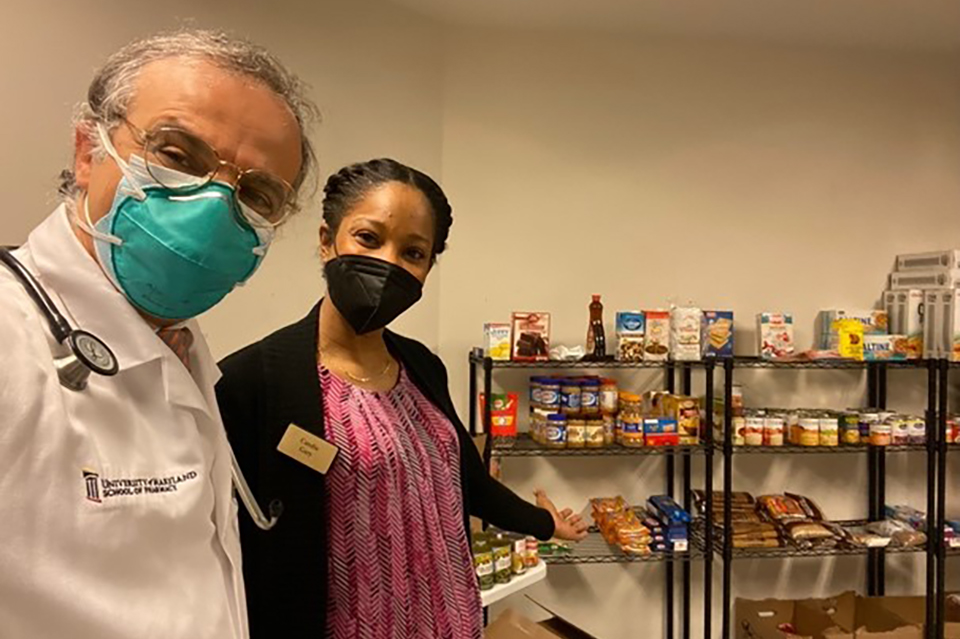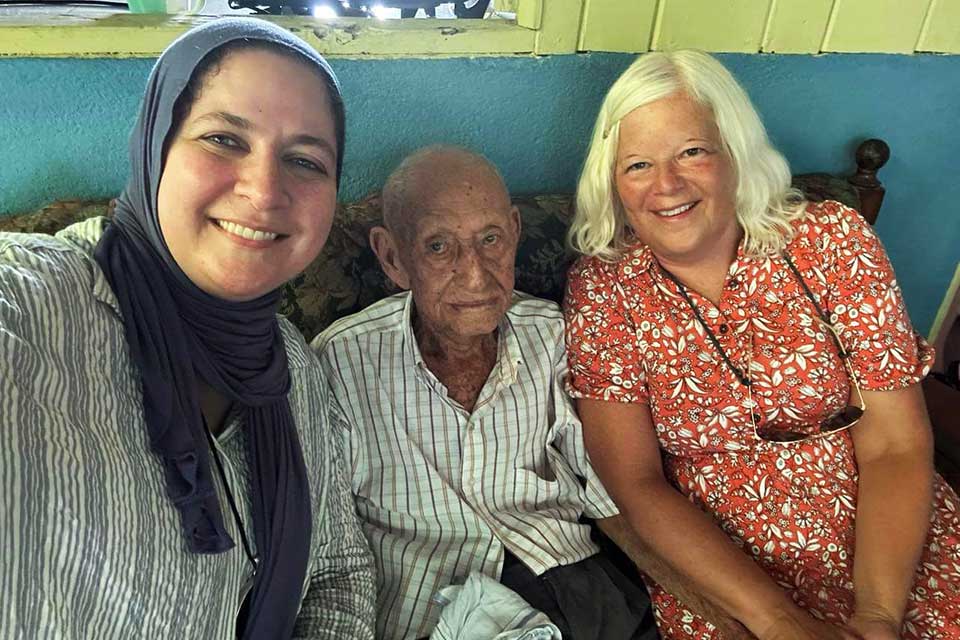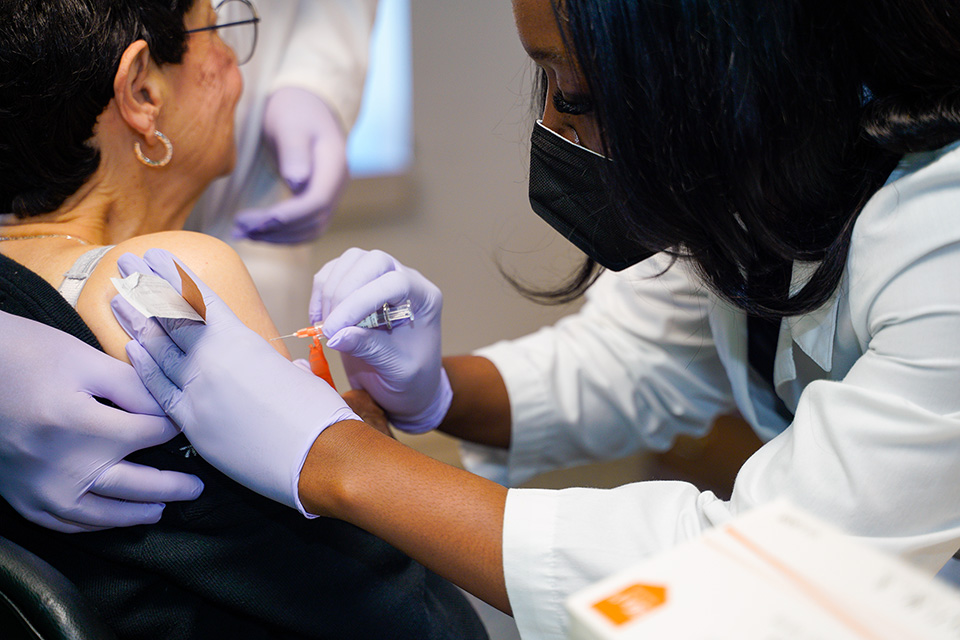Food Insecurity: An Interprofessional Approach
Students and faculty from an interprofessional team work to address food insecurity among community-dwelling older adults in Baltimore.

By Aanye Gafrey and Sonia Galvan
July 22, 2022
Food insecurity — the lack of access to enough nutritious food — has long been an issue in Baltimore, and worsened during the COVID-19 pandemic. An interprofessional (IPE) team of students and faculty based at the Peter Lamy Center on Drug Therapy and Aging at the University of Maryland School of Pharmacy in Baltimore has worked over the past year to combat this public health issue through assessing community needs and creating partnerships.
In 2020, an estimated one in eight Americans was food insecure. This equates to over 38 million Americans, including almost 12 million children. The U.S. Department of Agriculture defines food insecurity as a lack of consistent access to enough food for an active, healthy life. Though hunger and food insecurity are closely related, they are different concepts. Hunger refers to a personal, physical sensation of discomfort, while food insecurity refers to a lack of available financial resources for food in households. The IPE team worked to assess food insecurity among older adults in the Baltimore community at four Enterprise residential properties. The survey was tailored to specific property needs and was derived from evidence-based literature using stakeholder input.
This work began in late fall 2020 at the height of the pandemic. First, a survey on food insecurity was developed for property needs assessment and to generate recommendations for establishing food pantries (“Cafes”). These properties serve older adults with lower incomes as well as neighbors with disabilities. Students and faculty from the Interprofessional Education and Care in Geriatrics team, including the University of Maryland School of Pharmacy and the University of Maryland School of Nursing, distributed the survey and collected answers between April 2021 and July 2021. This provided an opportunity to chat with the neighbors and better understand their perspectives on access to nutritious food and barriers faced. Nearly 70 percent of the neighbors at these communities responded to the survey. This created an impactful experience for students and neighbors.
Second-year pharmacy student Ifunanyachukwu Azikiwe observed, “When we handed out surveys, I was able to have discussions with several residents about the need for a food pantry. Many cited the sharp increase in prices for common foods such as fresh produce and meats. The healthy food that they could previously afford had become overpriced and outside their budget. As a pharmacy student, I know that maintaining a balanced diet rich in fresh food is a key non-pharmacological intervention for several disease states. It is important to acknowledge the challenges patients may face to achieving optimum health and support workable solutions for food insecurity such as food pantries.”
Results from the survey showed a rich picture of the barriers to food security. Themes that emerged were not having enough food, the lack of balanced meals, the presence of financial hardship, and food-related stress or worry. The survey also assessed the types of food needed by neighbors, access to transportation, percentages and types of public funding used, and medical comorbidities. The need for better access to fresh fruits, vegetables, meats, and other sources of lean protein was expressed by neighbors at all sites. Transportation was a key access issue at all four residential properties. Nearly 50 percent of neighbors at one site stated it was fairly or extremely difficult for them to get to the grocery store. The most used transportation was riding with a friend or family, followed by walking, or using a taxi/hack/resident’s own car.
After reviewing the data with the Enterprise sites and team leaders, recommendations were discussed. These included increasing local partnerships, providing educational resources, prioritizing fresh foods and lean meats, and using best practices to improve the food pantry experience. As a result of the team’s work, a food pantry has already been successfully established at one of the sites and is helping to improve the food insecurity issues experienced by neighbors residing at that site. Continuing this work and implementing best practices will help to relieve the ongoing issues regarding food insecurity, such as delayed chain supply during the pandemic.
Providing older adults with the resources to access foods of sufficient quantity and nutritional quality is critical to their health and well-being. All individuals involved in the care of older adults should regard food insecurity as a cause of poor nutrition and a potential predictor of chronic disease and functional limitations. Work needs to be done to conduct nutritional intake assessments with older adults across all housing settings. The team recommended food pantry establishment at all properties and partnering with local food pantries/organizations such as the Baltimore Hunger Project for students at Baltimore City Public Schools. This work is a prime example of how interprofessional students, faculty, staff, and community partners can help improve older adults’ quality of life and make our communities more age-friendly.
Acknowledgments:
- Scotti Hutton, Community Network Manager, Enterprise Community Development
- Candis Gary, Assistant Property Manager, Metro Heights
- Daniel Mansour, PharmD, BCGP, FASCP, AGSF, and Nicole Brandt, PharmD, MBA, BCGP, FASCP, the Peter Lamy Center on Drug Therapy and Aging
- Ifunanyachukwu Azikiwe, PharmD Candidate 2024



